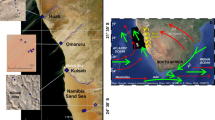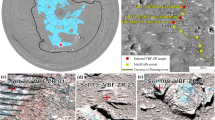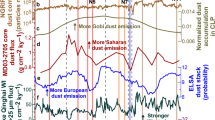Abstract
The ubiquitous atmospheric dust on Mars is well mixed by periodic global dust storms, and such dust carries information about the environment in which it once formed and hence about the history of water on Mars1. The Mars Exploration Rovers have permanent magnets to collect atmospheric dust for investigation by instruments on the rovers2,3. Here we report results from Mössbauer spectroscopy and X-ray fluorescence of dust particles captured from the martian atmosphere by the magnets. The dust on the magnets contains magnetite and olivine; this indicates a basaltic origin of the dust and shows that magnetite, not maghemite, is the mineral mainly responsible for the magnetic properties of the dust. Furthermore, the dust on the magnets contains some ferric oxides, probably including nanocrystalline phases, so some alteration or oxidation of the basaltic dust seems to have occurred. The presence of olivine indicates that liquid water did not play a dominant role in the processes that formed the atmospheric dust.
This is a preview of subscription content, access via your institution
Access options
Subscribe to this journal
Receive 51 print issues and online access
$199.00 per year
only $3.90 per issue
Buy this article
- Purchase on Springer Link
- Instant access to full article PDF
Prices may be subject to local taxes which are calculated during checkout


Similar content being viewed by others
References
Knudsen, J. M. et al. Mössbauer spectroscopy on the surface of Mars. Why? Hyperfine Interact. 68, 83–94 (1991)
Squyres, S. W. et al. The Athena Mars Rover science investigation. J. Geophys. Res. 108(E12), doi:10.1029/2003JE002121 (2003)
Madsen, M. B. et al. Magnetic properties experiments on the Mars Exploration Rover mission. J. Geophys. Res. 108(E12), 8069, doi:10.1029/2002JE002029 (2003)
Tomasko, M. G., Doose, L. R., Lemmon, M., Smith, P. H & Wegryn, E. Properties of dust in the Martian atmosphere from the Imager on Mars Pathfinder. J. Geophys. Res. 104, 8987–9007 (1999)
Lemmon, M. et al. Atmospheric imaging results from the Mars Exploration Rovers. Science 306, 1753–1756 (2004)
Pollack, J. B. et al. Properties and effects of dust particles suspended in the Martian atmosphere. J. Geophys. Res. 84, 2924–2945 (1979)
Squyres, S. W. et al. The Spirit Rover's Athena science investigation at Gusev Crater, Mars. Science 305, 794–799 (2004)
Squyres, S. W. et al. The Opportunity Rover's Athena science investigation at Meridiani Planum, Mars. Science 306, 1698–1703 (2004)
Hviid, S. F. et al. Magnetic properties experiments on the Mars Pathfinder Lander: Preliminary results. Science 278, 1768–1770 (1997)
Bertelsen, P. et al. Magnetic properties experiments on the Mars Exploration Rover Spirit at Gusev Crater. Science 305, 827–829 (2004)
Kinch, K. M. et al. Preliminary analysis of the MER magnetic properties experiment using a CFD model. Planet. Space Sci. (submitted)
Gellert, R. et al. Chemistry of rocks and soils in Gusev Crater from the Alpha Particle X-ray Spectrometer. Science 305, 829–832 (2004)
Rieder, R. et al. Chemical composition of Martian rocks and soils at Meridiani Planum from the Alpha Particle X-ray Spectrometer. Science 306, 1746–1749 (2004)
Yen, A. et al. An integrated view of the chemistry and mineralogy of Martian soils. Nature doi:10.1038/nature03637 (this issue)
Klingelhöfer, G. et al. Athena MIMOS II Mössbauer spectrometer investigation. J. Geophys. Res. 108, 8067–8084 (2003)
Morris, R. V. et al. Mineralogy at Gusev Crater from the Mössbauer Spectrometer on the Spirit Rover. Science 305, 833–836 (2004)
Schröder, C., Klingelhöfer, G. & Tremel, W. Weathering of Fe-bearing minerals under Martian conditions, investigated by Mössbauer spectroscopy. Planet. Space Sci. 52, 997–1010 (2004)
Klingelhöfer, G. et al. Jarosite and hematite at Meridiani Planum from Opportunity's Mössbauer spectrometer. Science 306, 1740–1745 (2004)
Levin, G. V. & Straat, P. A. Viking labeled release biology experiment: Interim results. Science 194, 1322–1329 (1976)
Hargraves, R. B., Collinson, D. W., Arvidson, R. E. & Cates, P. M. The Viking magnetic properties experiment: Extended mission results. J. Geophys. Res. 84, 8379–8384 (1979)
Madsen, M. B. et al. The magnetic properties experiments on Mars Pathfinder. J. Geophys. Res. 104, 8761–8779 (1999)
Morris, R. V. et al. Phyllosilicate-poor palagonitic dust form Mauna Kea Volcano (Hawaii): A mineralogical analogue for magnetic martian dust? J. Geophys. Res. 106, 5057–5083 (2001)
Yen, A. et al. Subsurface weathering of rocks and soils at Gusev Crater. Lunar Planet. Sci. Conf. XXXVI, 1571 (2005)
Smith, P. The Phoenix Mission to Mars. Lunar Planet. Sci. Conf. XXXV, 2050 (2004)
Acknowledgements
This paper is dedicated to the memory of Jens Martin Knudsen (1930–2005), who inspired and promoted our work with Mars over almost two decades. During his last year, a long-standing aspiration of his came true: a Mössbauer spectrum of martian dust was obtained. The Danish authors wish to thank the Athena Science Team and JPL engineers for supporting and carrying out the sometimes tricky, currently ongoing magnet observations on both rovers. Support from the Danish Research Agency, the Thomas B. Thrige foundation and DELTA Danish Electronics, Light and Acoustics is acknowledged.
Author information
Authors and Affiliations
Corresponding author
Ethics declarations
Competing interests
Reprints and permissions information is available at npg.nature.com/reprintsandpermissions. The authors declare no competing financial interests.
Rights and permissions
About this article
Cite this article
Goetz, W., Bertelsen, P., Binau, C. et al. Indication of drier periods on Mars from the chemistry and mineralogy of atmospheric dust. Nature 436, 62–65 (2005). https://doi.org/10.1038/nature03807
Received:
Accepted:
Issue Date:
DOI: https://doi.org/10.1038/nature03807
This article is cited by
-
Results from InSight Robotic Arm Activities
Space Science Reviews (2023)
-
Geologic Constraints on Early Mars Climate
Space Science Reviews (2019)
-
The Medusae Fossae Formation as the single largest source of dust on Mars
Nature Communications (2018)
-
Dust Devil Tracks
Space Science Reviews (2016)
-
Extraterrestrial Mössbauer spectroscopy: more than 3 years of Mars exploration and developments for future missions
Hyperfine Interactions (2008)
Comments
By submitting a comment you agree to abide by our Terms and Community Guidelines. If you find something abusive or that does not comply with our terms or guidelines please flag it as inappropriate.



